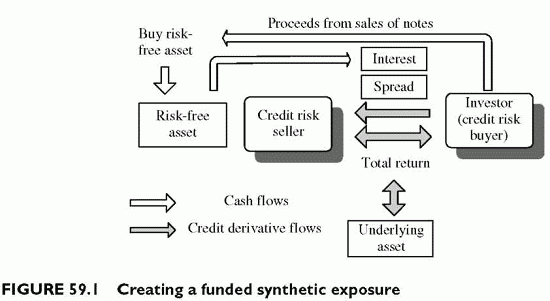CREATING SYNTHETIC EXPOSURES
Category: Risk Management in Banking
There is no need to stick to cash exposures with credit derivatives. By unbundling the credit risk component from the cash transactions, market players can create synthetic exposures that are not available in the cash market.
Creating a Synthetic Spread
Forward credit spread swaps provide protection against downside moves in credit quality. If a bank fears that the spread on a subset of its loans might widen in the future, it can offset the loss in (mark-to-market) value by entering into a credit spread derivative with a protection seller. This is also feasible for subportfolios, such as loans specific to an industry, using a pool of reference assets as underlying for the derivatives. In such a case, the derivative caps the widening of the credit spreads of the banks loans, or a credit spread collar keeps them within bounds.
Creating Synthetic Exposures
Without the proper infrastructure, some investors have no access to the loan market. In addition, banks might be willing to create exposures that they do not have. Any investor can create a synthetic exposure by selling credit risk protection without holding the underlying asset. The simplest transaction is to enter into a total return swap that entitles the seller to get the total return, positive or negative, while receiving a preset spread from the buyer of the protection. The seller of the total return swap gains a full synthetic exposure to the underlying asset. However, he has to pay the risk-free rate plus the spread to the protection buyer.
Another way to get a synthetic exposure replicating an existing reference asset is to create a combination of a cash investment and a total return swap or a default option. The investor acquires the total return of the reference asset with a swap and invests simultaneously in risk-free assets. By selling a credit protection, or buying the risk, the investor pays an interest plus some margin to the protection buyer and gets the total return of the reference asset. In order to generate the interest flow due to the credit risk seller (the buyer of protection), the investor enters simultaneously into a cash investment. The interest received serves to fund the interest paid to the buyer of protection. In the end, the investor invests the same amount as in a risky loan, but does so in a risk-free asset.
With a credit default option, the investor insures the risk seller against default, making it necessary to pay the net loss under default if the default occurs. The investor buys an amount of risk-free asset equal to this preset loss under default. He uses the interest proceeds to pay the interest due to the risk seller. In exchange, he receives the fees plus any spread from the credit risk seller. The cash investment by the investor fully funds the acquired exposure to default (Figure 59.1).
This scheme involves cash transactions on risk-free assets while gaining exposure to credit risk through derivatives. Since the investor is at risk with the credit risk seller, this seller should have a good credit risk standing. This is a generic scheme that also applies to synthetic securitizations (synthetic collateralized loan obligation). Essentially, the cash investment guarantees the cash exposure of investors, using the proceeds from sales of notes to investors, while the credit derivatives reshape the risk-return profile, so that players trade spreads and total returns only.
Securitization and Capital Management
Securitization is a technique used to sell balance sheet assets to outside investors. It ensures compensation to investors with cash flows generated by the pool of assets sold. Securitizations issue structured notes, funding the securitized assets, over the entire spectrum of credit risks. To differentiate the risk of notes, the structure routes the flows generated by the pool of assets towards notes according to seniority rules. In addition, covenants rule the life of the structure, notably by triggering early amortization whenever the credit risk deteriorates beyond specified thresholds.
The common rationales for securitizations are to arbitrage the cost of funding on-balance sheet with funding in the market or to off-load risks in the market to save capital. Securitizations vary widely by type of assets securitized, from credit cards to loans or leasing receivables, and in the structuring of the notes, by size and seniority level. Structures for off-loading credit risk in the market are Collateralized Debt Obligations (CDOs), Collateralized Bond Obligations (CBOs) and Collateralized Loan Obligations (CLOs). The differences relate to the nature of assets securitized, tradable or not. Cash CDOs rely on the actual sale of assets to the dedicated vehicle issuing structured notes to investors. Synthetic CDOs use credit derivatives to sell only the risk of a pool of assets, or a fraction of their risk, while keeping the assets on-balance sheet, and still saving capital. The economics remain similar however.
The non-recourse sales of assets necessarily save economic capital. Securitizations would be of limited interest unless they improve profitability. This implies looking to the overall economics of the transaction: capital savings; the differential cost of funding on-balance sheet and through the market; the effect on the return on capital; the capital gains or losses from the sale of assets to the SPV; the direct costs of setting up the structure and operating it.
This chapter details the economics of a simple securitization, the nature and the influence of drivers of its profitability.
The first section explains the basic mechanisms of securitization. The second section analyses the economics of the transaction. The third section details, through an example, the cost of the transaction from the asset sellers perspective. The fourth section looks at the risk-return effect on the banks overall portfolio. The fifth section details the leverage effect of securitization on the return on economic capital of the seller of assets. The last section addresses the issue of structuring the notes, rather than analysing the economics of a transaction given a structure of notes.

